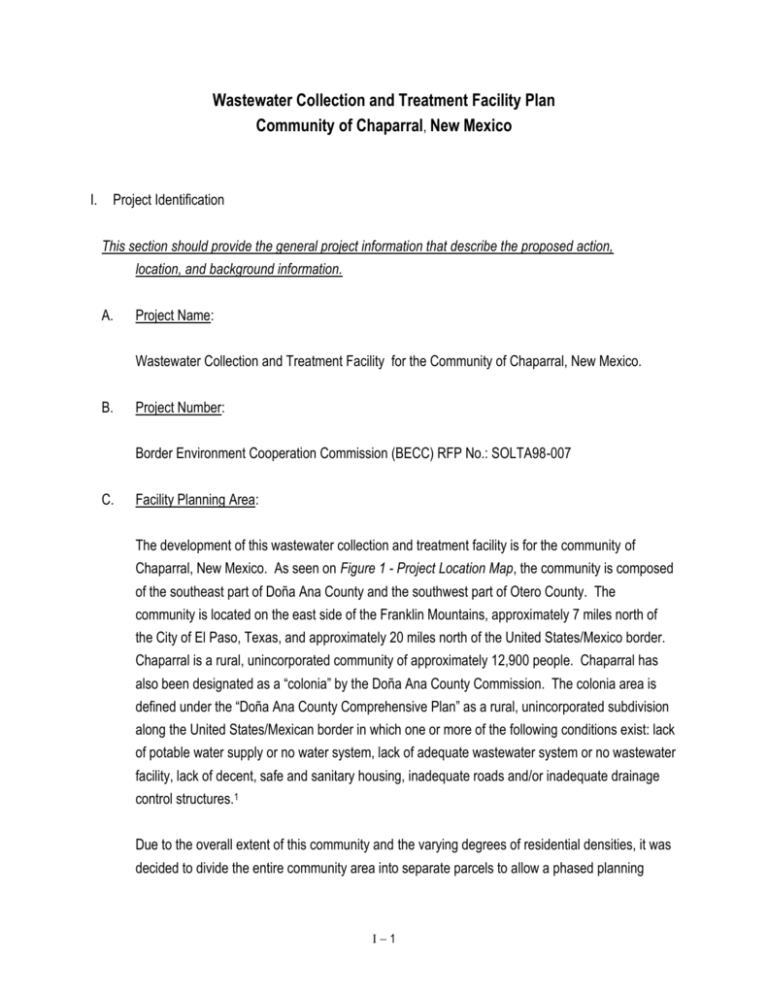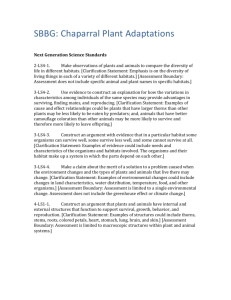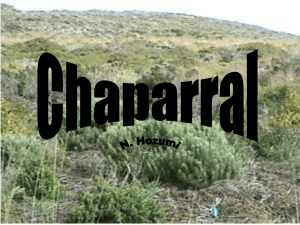Wastewater Collection and Treatment Facility Plan
advertisement

Wastewater Collection and Treatment Facility Plan Community of Chaparral, New Mexico I. Project Identification This section should provide the general project information that describe the proposed action, location, and background information. A. Project Name: Wastewater Collection and Treatment Facility for the Community of Chaparral, New Mexico. B. Project Number: Border Environment Cooperation Commission (BECC) RFP No.: SOLTA98-007 C. Facility Planning Area: The development of this wastewater collection and treatment facility is for the community of Chaparral, New Mexico. As seen on Figure 1 - Project Location Map, the community is composed of the southeast part of Doña Ana County and the southwest part of Otero County. The community is located on the east side of the Franklin Mountains, approximately 7 miles north of the City of El Paso, Texas, and approximately 20 miles north of the United States/Mexico border. Chaparral is a rural, unincorporated community of approximately 12,900 people. Chaparral has also been designated as a “colonia” by the Doña Ana County Commission. The colonia area is defined under the “Doña Ana County Comprehensive Plan” as a rural, unincorporated subdivision along the United States/Mexican border in which one or more of the following conditions exist: lack of potable water supply or no water system, lack of adequate wastewater system or no wastewater facility, lack of decent, safe and sanitary housing, inadequate roads and/or inadequate drainage control structures.1 Due to the overall extent of this community and the varying degrees of residential densities, it was decided to divide the entire community area into separate parcels to allow a phased planning 1 INSERT FIGURE 1 HERE 2 approach. Figure 2 - Wastewater Facility Plan Area, presents the individual planning areas defined for Chaparral. The facility planning areas include the Core Area of central Chaparral and areas outside the Core Area identified as Extended Areas 1, 2, 3, and 4. Brief descriptions of each planning area are provided as follows: 1. Core Area: The Core Area is located in the central part of Chaparral and encompasses the majority of the more densely populated area of the community. The Core Area is approximately 6,836 acres (10.68 square miles) in size and incorporates a portion of both Doña Ana County and Otero County. The majority of the Core Area consists of single family residential homes. Several areas along Lisa Drive, McCombs Road and County Line Road are occupied by small businesses. 2. Extended Area 1: Extended Area 1 is located on the east side of the Core Area. The majority of Extended Area 1 is currently vacant with the exception of the far north end which has already been developed as residential area. Extended Area 1 is approximately 2,136 acres (3.34 square miles) in size. 3. Extended Area 2: Extended Area 2 is located southwest of the Core Area. The majority of Extended Area 2 is also currently vacant. Extended Area 2 is approximately 1,893 acres (2.96 square miles) in size. 4. Extended Area 3: Extended Area 3 is located northwest of the Core Area. The majority of the Extended Area 3 is currently under development as a residential area. Extended Area 3 is approximately 1,626 acres (2.54 square miles) in size. 5. Extended Area 4: Extended Area 4 is also located northwest of the Core Area and north of Extended Area 3. The majority of Extended Area 4 is currently vacant with minimal development. Extended Area 4 is approximately 1,295 acres (2.02 square miles) in size. D. Description of Proposed Project: Under this facility plan, detailed design analysis will only be performed for the Core Area. The detailed analysis will include the projected population and anticipated sewer flow, sewer line sizes and alignments, the required appurtenances, and the preliminary cost estimates. For the Extended Areas, only a planning effort will be performed because the majorities of land are vacant and unpredictable future land use in these areas. The planning effort will only include estimating sewer flows and identifying locations of future sewer line connections to the Core Area collection system. Projected populations and estimated sewer flows for the Extended Areas will be used to establish wastewater treatment plant design criteria, and impacts to collection system lift station and main pipe capacities. Costs for extension of wastewater service to these areas are not within the scope of this report. 3 INSERT FIGURE 2 HERE 4 E. Background Information: The Community of Chaparral originated when Mr. P. K. Colquitt purchased a ranch, which is now known as Chaparral, from his stepfather in approximately 1950. Mr. Colquitt operated the ranch for approximately 10 years. Due to a severe drought during this time, he decided to begin subdividing the land. The first subdivision plat was filed in 1961. Since then, many improvements have been made to the community of Chaparral which include: Installation of a private water utility system Installation of telephone and television utility networks Installation of a electric utility system County maintained paved and unsurfaced roadways Solid waste disposal service is provided by several private companies Rural postal delivery service is provided and a postal sub-station was constructed Volunteer fire departments in both counties were created A community park was constructed An elementary school, an intermediate school, and a middle school have been constructed within the community Although with the above many improvements, Chaparral still lacks any type of central wastewater collection and treatment system. Residents in Chaparral area dispose of their liquid waste either to septic tanks or cesspools. These wastewater disposal practices are undesirable due to the increasing density of septic tanks. Combined with highly permeable soils that exist in the Chaparral area, this disposal practice creates a severe threat of ground water contamination. 2 There are no other communities of this size and population in the State of New Mexico that do not already have a central wastewater utility system to provide service for their residents. This wastewater facility plan was prepared for Doña Ana County who is the project sponsor. This project is funded through the Border Environment Cooperation Commission (BECC), which is established by the Government of the United States of America and the Government of the United Mexican States. The purpose of BECC is to help preserve, protect, and enhance the environment of the border region in order to advance the well-being of the people of the United States and Mexico. The border region is defined in BECC’s Project Certification Criteria as within 100 km (62 miles) on either side of the U.S./Mexico border. In carrying out this purpose, the BECC will cooperate with the North American Development Bank (NAD Bank) and other national and international institutions, and with private sources supplying capital for environmental infrastructure 5 projects in the border region. D:\687321797.DOC 6










